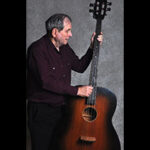“There’s not just one, but there’s one that suits you”
By Jon Liebman
November 4, 2022
When you practice your scales, do you know what fingering you’re going to use, or do you just muddle through each scale until you get where you want to go?
While most scales can be fingered in a number of ways, in the long run, you’ll be better off if you apply consistent fingerings while you practice them.
That doesn’t mean you should only learn one fingering for each type of scale. Rather, you should decide on which fingering you’re going to use and apply it to all scales of that type, in every key, regardless of where you’re playing them on the bass.
Stay with me; this will make total sense to you!
The topic came up during a great conversation I had a couple weeks ago with my old friend, fellow bassist – and fellow Detroiter! – Robert Hurst.
Robert’s played with everyone from Paul McCartney and Sting to Dave Brubeck and Wynton Marsalis, not to mention holding down the bass chair in The Tonight Show band for eight years and his longtime gig with pianist/vocalist Diana Krall.
I asked him what advice he had for someone who wants to learn bass, especially for people dealing with things like arthritis, tendonitis, and other things that happen to us as we get older.
Loosen up
Before getting into the technical stuff, Robert emphasized the importance of warming up before doing any kind of practicing or performing. You want to make sure you’re approaching the bass wisely and avoiding injury.
“It’s a very physical instrument,” Robert says, “whether it’s electric bass or upright bass, so I would say start slow and really warm up. It’s easy just to jump on the bass and start playing, especially if you love it so much and you’re not a professional musician, you just want to play.”
Warming up is important for professionals too, Robert says, citing his own story of a tennis injury he endured a while back that did some damage to his hand.
“I started doing physical therapy,” he recalls, “just a series of stretches. One thing my physical therapist said, just run in place, or (do) a few jumping jacks before you start, to get the blood flowing and get your body temperature up.”
Learn universal fingerings for your scales
Then he started talking about learning bass technique and the subject of scales came up.
“Learn a universal fingering for all your scales,” he says, “every major scale, every pentatonic scale, every whole tone scale… That way you just start in this one place and your fingers do the walking, as it were.”
I thought this was great advice. I always tell my students they can use any fingering they want, my only rule being: Pick one! That kind of consistency will increase your confidence as a bass player and dramatically improve your overall command of the instrument because you know where you are and you know where you’re going.
I encourage my students to learn multiple fingerings for their scales and modes. I just want them to be focused on the one they’re playing now and stick to it. The advantages of this approach are fantastic.
“You don’t have to really think about the notes as much,” says Bob on the benefits of universal fingerings. “You just think about your hand and muscle memory and all of that kind of thing.”
Find the one that suits you
The conversation reminded me of one time in college when I was admonished by a member of the music faculty during a jury when I played a scale using one fingering on the way up and another on the way down. [Just a tangent: There are times when it’s totally appropriate to do that, but that’s another story for another day!]
“The more you study the bass,” Robert continued, “you’ll come up with many universal fingerings. There’s not just one, but there’s one that suits you.”
That last comment got us sharing stories about Jaco and some of his unorthodox fingerings, like playing the first three notes of a major scale all on one string, with each note a full two frets away from the next. I don’t know about you, but that sure doesn’t feel natural to me!
It also reminded me of my recent interview with Dr. Randall Kertz, who said sometimes you have to modify your hand position, ever so slightly, to accommodate the bass around your body. You need to honor good technique, but you may need to tweak it slightly to suit your needs.
Improving the mind/body connection
There’s a reason certain scale fingerings have become commonplace over the years. Our bodies are basically similar in structure and most of us find certain approaches easier than others.
Sometimes, though, what comes naturally to one person may be awkward for someone else. Find what works for you, then apply it all over the bass.
It’s also a great thing that the bass is tuned in fourths, all the way up and down. With few exceptions, that means if you can play something anywhere on the bass you can play it everywhere on the bass. Take advantage of that symmetry.
Learn as many fingerings as you can for each scale then apply a universal fingering to every one, in every key. It will force your mind and body to work together, making you a better bass player and a better all-around musician.
Your turn. How do you approach practicing your scales? Do you use universal fingerings or do you just do “whatever” to get from one note to the next? Leave a comment below and share your story. And be sure to watch my interview with Robert. here.






Hi Jon,
Yes, no, maybe… When learning, we need to start small and simple. Using a universal fingering pattern to get started is a good idea. But over time, it can turn into a barrier. I’ve spent the last few years trying to open up my view of the fret board. I was provoked by the first suggestion in guitarist Mick Goodrick’s guitar book where he wrote “First Thing to Learn: Up and Down a String (Single String Playing)”. He goes on to write that “you have no real understanding of the fingerboard until you’ve spent a lot of time playing up and down the strings individually.” While I’m not sure it’s the first thing to learn, it certainly is important at some point to break away from playing in a set universal fingering of scales. Also, Victor Wooten points out that being able to play riffs or scales in several ways allows one to lessen the strain of playing a lick over and over (while the guitarist plays endless choruses in Em pentatonic!) After all, there’s a reason it’s called “Repetitive Motion Syndrome.” So by all means, start with universal patterns. But don’t get trapped in them.
Good points, Charlie. My point is to learn a specific fingering and apply it all over the bass. I absolutely encourage learning differing fingers and applying those as well. It’s a matter of structure, consistency and awareness of what you’re playing. By all means, learn as many fingerings as you can! Just know which one you’re going to use when you practice and be aware of what you’re playing. Thanks for the comment!